 At Fremont Christian School, our instructors use a research-based teaching model known as GLAD (Guided Language Acquisition Design). Studies have shown that using GLAD in classrooms leads to high-quality instruction that both supports English-language development and challenges high-performing students within the same classroom environment.
At Fremont Christian School, our instructors use a research-based teaching model known as GLAD (Guided Language Acquisition Design). Studies have shown that using GLAD in classrooms leads to high-quality instruction that both supports English-language development and challenges high-performing students within the same classroom environment.
From elementary school through high school graduation, FCS students receive instruction through GLAD in all areas of teaching, where they employ high-level vocabulary, practice metacognition (thinking about their own thought processes), and take more responsibility for their own learning — all embodiments of 21st-century skills. The GLAD model emphasizes solving one’s problems, respecting others, and making good choices. Metacognitive learners are able to think about their own learning: Does this make sense? How am I doing? What am I doing well? What can I do better?
Many of the parents who chose FCS did so because of the studies that show GLAD to be an effective instructional model for supporting language development and academic achievement. By using Project GLAD, schools provide a structured approach to teaching that is focused on supporting students' language acquisition and academic growth. The use of visual aids and explicit language instruction can also benefit students who may struggle with traditional instructional methods. The collaborative learning environment of GLAD can also help students develop important social skills and build community in the classroom.
“GLAD is a great system because it uses proven strategies that are already widely used amongst teachers,” says Kristen Wong, who teaches fourth grade at FCS. “What GLAD does is organize those strategies to help students best process the information. This allows students — both current and new enrollees — adapt easily to the FCS way of teaching and feel at ease.”
One strategy GLAD uses is expert groups, where students study a topic in a collaborative group and teach their peers. Another strategy includes using graphic organizers during direct instruction, which tie visual elements to academic language to provide scaffolding and imprint on the brain. [Photo of third-grade pictorial input chart.]

In studies of GLAD usage, students were found to have improved slightly in reading but significantly in vocabulary acquisition. The focus students showed improved confidence and grammar when speaking, while the overall class showed increased accountability, increased family engagement, improved reading stamina, and increased collaboration among students. These findings suggest that GLAD is beneficial for all students, but especially to develop a larger working vocabulary that leads to greater academic achievement.
The Project GLAD method and organization was developed by Linnea Haley and Marcia Brechtel to provide a framework of more than 200 teaching strategies based on brain-research. It has received distinction from the California Department of Education as an Exemplary Model and from the United States Department of Education as a Model of Academic Excellence.

